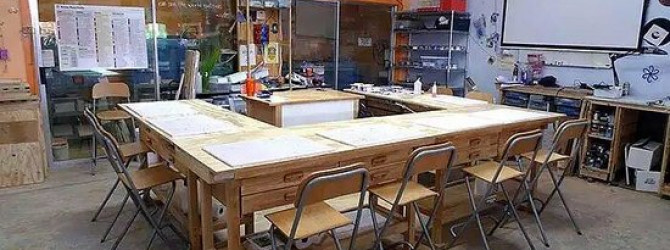
How to Choose A Good Fused Glass Teaching Studio
There are some excellent (and some terrible) fused glass teaching options out there.
Here are some guidelines to help you choose a good studio to begin, or continue, your fused glass education.
Ask to see the instructor’s work
Asking to see the instructors’ work will tell you a couple of things.
First, it will allow you to evaluate their skill level. This isn’t about judging their art – it is about looking at the quality of their craftsmanship. Are the edges finished neatly? Is the surface free from devitrification? Do pieces fit together neatly? You may not find their work attractive or interesting – but, it should still be well made.
The second thing you may glean by asking to see the teacher’s work is a sense for how freely they share information. Some teachers don’t like to show their work to students for fear the students will copy them. Run away from these teachers – they are like chefs who share recipes but always leave out a key ingredient.
If the instructor does show you their work, ask how it was done. The answer “you need to take a class for that” is another red flag. Good teachers recognize there is a big difference between a quick answer and quality instruction. If they are worried that the quick answer will “give away” the meat of the class, there probably isn’t much meat there.
Look at work completed by other students
Student work will always be abundant at any studio that focuses on teaching.The best evidence of good teaching is good work by their students.
As stated above, this doesn’t mean you are looking for “great art” – just that students mastered the techniques being taught.
Look for the kilns
An amazing number of fused glass teaching studios have their kilns hidden out of their students’ sight. Think about that: students never (or rarely) see the fused glass artist’s most important tool. That would be like taking a carpentry class but never seeing the hammer.
If access to kilns isn’t integral to the classroom, then there is a good chance the studio teaches “magic fusing”.That’s where a student makes something, it gets whisked away, “magic” happens, and it comes back.
Not learning how glass is fired makes you overly dependent on the studio – which is good for them, but not so good for you. It also may be a sign that they don’t really understand glass firing schedules enough to teach them.
Visit while a class is being taught
This one is pretty obvious – but most people still don’t do it.
Before you spend hundreds of dollars and hours of your time on a fused glass class, ask to visit while a class is going on.Also, make sure the class you observe is taught by the same person who teaches the beginner class.
Some studios have great senior instructors for the advanced classes but don’t invest as much into their beginner classes. That’s too bad because your beginner class is probably the most important class you will ever take.
If the studio allows you to observe, be considerate to not disturb the class and don’t overstay your welcome. You will likely learn what you need to know about the teacher in the first five or ten minutes.
Ask what is covered
A good beginning fused glass should include a discussion of all of the following:
- what glass can be fused (and why)
- how glass melts
- firing schedules
- problem solving
If your would-be instructor doesn’t include these in the description of the class, then you should proceed with caution.
Ask about tools and supplies
Avoid any fused glass class that requires you to purchase your own tools. There is no reason to invest hundreds of dollars or more before deciding this is something you want to continue.
There is nothing wrong with using scrap fusible glass in a beginner class – so long as the scrap supply offers a good choice of colors. There should also be a selection of frit and stringer so that you can get some experience working with these popular accessory glasses.